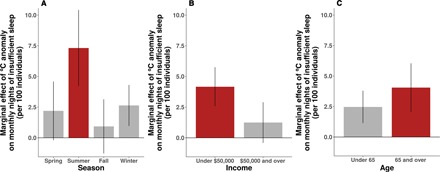Understanding how to leverage bedroom temperature can upgrade your sleep instantly. There’s a reason people sleep less in the summer. They also nap less in the winter. Optimizing bedroom temperature can exploit these mechanisms. What is the optimal bedroom temperature? How can you utilize it to wake up and fall asleep quicker? And what protocols can you implement to transform your sleep quality? Well, let’s get into it!
Before Sleep Onset
Of the factors affecting sleep, temperature plays a key role. Normal sleep-wake cycles are governed by daily circadian rhythms. That’s our 24-hour internal clock. Our body temperature peaks in the afternoon around 6pm at 99.5°F. Then, it plunges to around 97.5°F in the early morning around 4am. This cycle repeats every day and is critical for both falling asleep and staying asleep [1]. If we deviate from this cycle of body cooling in the evening, we experience insomnia [2]. An inability to fall asleep. But by understanding this process we can leverage it to fall asleep quicker.

How can we encourage body cooling in the evening? Surprisingly, by warming up. Each night, blood vessels dilate in your hands and feet. This increased blood flow extracts heat from your core and releases it from your extremities. To enhance this natural process, we can do a few things. Taking a warm bath or hot shower an hour before bedtime dilates those vessels and flushes your skin with blood. As you get out of the water, your core temperature sinks from all the blood being on the skin’s surface. This is called the warm bath effect [2]. While I’m not a bath bro or nighttime shower-er, I’d be interested in using a sauna for this. A quick 20-minute sauna session before bed sounds great. Don’t tell Vicki I’m saving up for one.
Another way to encourage body cooling is by warming the hands or feet. Turns out sleeping with socks is good. And sleeping with gloves is still weird. Although both these methods help mice and humans fall asleep reliably quicker. They help blood vessels dilate in the extremities so core heat can pour out. It’s no wonder all mammals seek shelter, build a nest, and curl up at night [2]. Getting warm before bed helps you get cool in bed.
During Sleep
Once you’re in bed, the script flips. You want to stay cool to stay asleep. That’s why many people reliably sleep less in the summer. Especially if you don’t have AC. Hot temperatures and bright sunlight decrease sleep duration and quality. This causes a rebound nap effect. On the other hand, colder winter temperatures and decreased sunlight cause us to sleep longer. Therefore, needing naps less. But with heating and air conditioning, we can control these factors to optimize sleep year round.

Setting your thermostat between 65° and 67°F produces the best results in most. Aim for 40-60% humidity too [4]. Even if you don’t see a noticeable difference on your sleep tracker, it doesn’t mean it’s not working. These cooler temperatures enhance electrical brainwave activity at night producing higher quality sleep. This isn’t something your Fitbit can track yet.

On top of this, bedding is necessary too. Bed sheets and comforters create a microclimate that your body can automatically manage. You’ll adjust your bedding throughout the night without realizing it. Exposing more skin to cool down. Or curling up to stay warm. I utilize my Ooler Sleep System to manage my mattress temperature throughout the night too. I’ve programmed it to stay at a cool 70°F. If heating or cooling your entire house is too expensive, then this local sleep system might help. It’s also useful if you have a partner with different temperature preferences. You can have it colder while they have it warmer. But its best feature may be the warm awake alarm.
Before Sleep Termination
Encouraging body warming in the morning is key to waking up fresh. The Ooler sleep systems allows me to warm the bed 30mins before rising. I also set my thermostat to warm the apartment 30mins before waking too. And if you need that hot coffee to get yourself going, it may be the heat and not the caffeine that’s jumpstarting you. Even a warm glass of water in the early morning helps raise core body temperature. Combining a few of these body warming techniques with early morning sun exposure and light exercise can set you up for the perfect day.
Final Thoughts
Who knew temperature played such a vital role in optimizing sleep? Me! After reading the research… Getting warm an hour before bed helps drop core body temperatures. So, you’ll fall asleep quicker. From there a chilled bedroom between 65° and 67°F helps you stay asleep. And the quality of that sleep improves too. Finally, a rise in room temperature 30mins before waking can promote alertness. And a warm drink might help too. This is making me reconsider drinking morning tea. I need to get back to that. These are my latest habits for health excellence.

